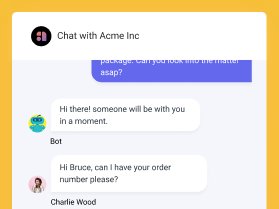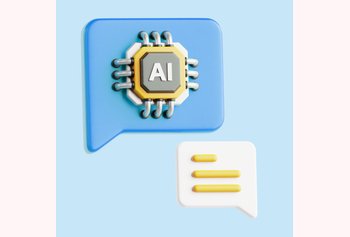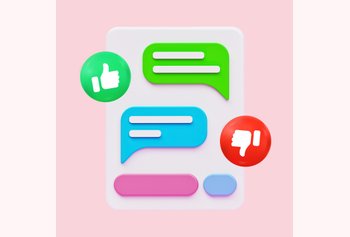NLP Chatbots: What They Are, How They Work, and Key Applications

Table of contents
You ask a chatbot a question, and it responds like a human. It understands what you’re saying, keeps track of the conversation, and even adapts its replies based on context. This isn’t just a basic script responding to keywords—it’s an NLP chatbot at work.
Unlike traditional bots that follow fixed rules, NLP (Natural Language Processing) chatbots interpret language, detect intent, and adjust responses accordingly. That’s why they’re everywhere—handling customer support, assisting in healthcare, automating workflows, and more.
But how do they actually work? What sets them apart? And where are they making the biggest impact? Let’s break it down in this blog.
Table of Contents
- What is Natural Language Processing (NLP)?
- How Do NLP Chatbots Work?
- Difference Between NLP Chatbots and Rule-Based Chatbots
- Chatbot Comparison: Rule-Based vs. NLP
- Key Components That Make NLP Bots Smart
- Key Applications of NLP Chatbots
- Benefits of NLP Chatbots
- Challenges and How to Overcome Them: Can NLP Pass the “Human” Test?
- Trends in NLP Chatbots
- Do You Really Need an NLP Chatbot?
What is Natural Language Processing (NLP)?
Do you remember how you learned to respond to everyday conversations in your familiar language? NLP tries to do the same but with a computer on the other side. It’s a branch of AI that focuses on enabling computers to understand, interpret, and generate human language.
When a customer types, “My order hasn’t arrived yet,” a simple keyword-based bot might only recognize “order” and “arrive,” triggering a generic response about shipping times.
However, an NLP-powered bot understands the meaning, concern, and annoyance behind the sentence, which allows it to provide a more relevant and helpful response. But how exactly do these chatbots work?
How Do NLP Chatbots Work?
NLP uses a combination of techniques, including:
- Tokenization: Breaking down text into individual words or phrases (tokens).
- Parsing: Analyzing the grammatical structure of sentences.
- Sentiment Analysis: Determining the emotional tone of the text (positive, negative, neutral).
- Entity Recognition: Identifying key information like names, dates, and locations.
While basic chatbots rely on pre-programmed scripts and keyword matching, NLP-powered chatbots can engage in more natural and dynamic conversations.
For example, when a customer contacts a travel agency’s chatbot with the message, “I’m looking for a getaway to Europe in October.” A basic chatbot might ask a series of rigid questions: “What is your budget? What dates are you traveling?”
Whereas an NLP chatbot can understand the intent behind the message and ask more relevant follow-up questions: “Are you interested in city breaks, beach vacations, or something else? Do you have any specific countries in mind?” This allows the chatbot to provide more personalized recommendations and a better overall customer experience.
Difference Between NLP Chatbots and Rule-Based Chatbots
Understand the difference by this simple example. You’re trying to order a pizza online.
Scenario 1: The Traditional Rule-Based Bot
You type: “I want a pepperoni pizza.”
The bot replies: “Please enter your order using the following format: Pizza Type: [Type], Size: [Size], Crust: [Crust].”
You try again: “Pepperoni pizza, large.”
The bot: “Invalid input. Please specify crust type.”
Frustrating, right? This is often the experience with rule-based chatbots. They operate on strict, pre-programmed rules and can only understand very specific inputs.
Scenario 2: The NLP Bot
You type: “I’m craving pizza. Something meaty.”
The bot responds: “Great! We have a delicious pepperoni, a hearty meat lovers, and a spicy Italian sausage. Which sounds best?”
You: “Pepperoni sounds good.”
The bot: “Perfect! What size and crust would you like?”
This interaction is powered by an NLP (Natural Language Processing) chatbot. These bots use AI to understand the intent behind your words, even if you don’t use the exact phrasing they expect.
Chatbot Comparison: Rule-Based vs. NLP
| Feature | Rule-Based Chatbots | NLP Chatbots |
|---|---|---|
| Understanding Language | Relies on exact keyword matches. | Understands the meaning and context of your words, including misspellings and different phrasing. |
| Conversation Flow | Follows a rigid script, leading to dead ends if you deviate. | Can handle more complex, dynamic conversations. |
| Learning and Improvement | Only improves when a programmer manually adds more rules. | Learns from every interaction, becoming more accurate over time. |
Key Components That Make NLP Bots Smart
Below mentioned components work together to allow chatbots to receive input, understand it, generate a relevant response, and refine their performance over time.
- Dialogue Management: This is like the bot’s memory. It keeps track of the conversation history, so it remembers what you’ve already discussed. For example, if you mentioned your account number earlier, the bot can refer back to it later.
- Human Handoff: Sometimes, a bot can’t handle a complex issue. A smooth handoff to a human agent is crucial for a positive customer experience.
- Business Logic Integration: This connects the bot to real-world systems, like order databases or customer accounts. This allows the bot to take actions, like checking your order status or updating your information.
- Rapid Iteration & Ongoing Training: Bots constantly learn from real conversations. This helps them improve their understanding and provide better responses over time.
- Simplicity & Optional Advanced Features: The best bots are easy to use and can be customized to fit specific business needs, including features like seamless integration with backend systems, personalized interactions, and pre-training on real customer interactions.
Key Applications of NLP Chatbots
1. Customer Support
NLP chatbots are changing how businesses handle customer support. Instead of making customers wait in long queues or sift through endless help articles, chatbots can provide instant answers, automate repetitive tasks, and route issues to the right person when needed.
Take Hiver’s chatbot, for example. It doesn’t just sit on your website answering FAQs—it works within your existing workflows to make support teams more efficient. No need to rip and replace your current setup. Here’s how:
- Quick and easy setup: Hiver’s chatbot is easy to configure and deploy. It integrates with the tools your team already uses, so there’s no disruption to daily operations.
- Rule-based automation: It handles common queries like password resets or company policies in seconds. Ask about PTO policies, and the chatbot fetches the details instantly—no back-and-forth emails.
- Seamless escalation: When a request requires human intervention, the chatbot smoothly transfers it to an agent, ensuring the conversation continues without frustration.
2. E-commerce and Sales
Have you ever walked into a store and had a salesperson suggest something extremely useful that you didn’t even know you needed? NLP chatbots can replicate this experience online.
Scenario: A customer is browsing for hiking boots. The chatbot might ask, “Are you planning any specific hikes? What kind of terrain will you be on?” Based on their answers, the chatbot can recommend specific boot models, suggest appropriate socks, or even offer a discount on a hiking backpack.
A customer adds an item to their cart but doesn’t complete the purchase. The chatbot can send a friendly reminder, perhaps offering a small discount or free shipping to encourage them to complete the transaction. This directly addresses cart abandonment.
Instead of a generic email blast, NLP chatbots can send personalized messages like, “We noticed you’re a fan of our X model running shoes. We’re excited to announce the new X Pro, with improved cushioning and breathability!”
The chatbot can instantly access the order tracking system and provide real-time updates without requiring a human agent. Handling frequently asked questions (FAQs) about shipping, returns, or product information can be fully automated, freeing up your customer service team to handle more complex and high-value tasks.
NLP chatbots can identify trends in customer preferences, common questions, and pain points in the customer journey. This insight can lead to improvements in website navigation and product categorization. If an item is out of stock, the chatbot can provide an estimated restock date or suggest similar products.
3. Healthcare
AI-powered healthcare chatbots offer real-time, 24/7 support, making it easier for patients to access the care they need. This consistent assistance provides accurate, contextual, and up-to-date answers all the time.
It can help with appointment scheduling, payments, accessing old patient records, and more. By handling routine inquiries and administrative tasks, chatbots free up clinicians to focus on what they do best: providing expert medical care.
4. Human Resources
All of us have felt lost navigating company policies, especially as a new hire or while working remotely. Or maybe you’ve hesitated to bother the HR with a simple question you thought others might already know everything about!
We’ve now reached a world where you can instantly get answers to your HR questions, access important documents, and even clear routine attendance checks, etc, all due to the power of HR/employee chatbots.
They can also perform actions and access information from various internal systems. Instead of searching through endless files and folders, employees can simply ask the bot for what they need.
Benefits for HR and employees:
- Reduced HR workload: Automating routine tasks frees up HR staff to focus on strategic initiatives.
- Improved employee experience: Instant access to information and support improves employee satisfaction and efficiency.
- Enhanced onboarding: New hires can quickly get up to speed with company policies and procedures.
Benefits of NLP Chatbots
NLP chatbots do more than just reply to messages—they make conversations smoother, faster, and more efficient. Here’s why businesses rely on them:
- Instant responses: No waiting in queues or searching through FAQs. Chatbots provide quick answers, keeping customers and employees productive.
- Available 24/7: Support doesn’t stop after business hours. Whether it’s a simple query or a troubleshooting request, chatbots handle it 24×7.
- Reduces repetitive work: Chatbots take care of common questions like password resets, refund policies, and order tracking, so human agents can focus on more complex issues.
- Understand context and intent: Unlike basic bots that rely on keywords, NLP chatbots recognize meaning and respond naturally, even when phrased differently.
- Seamless handoff to humans: When a request needs a personal touch, the chatbot routes it to the right agent without losing conversation history.
- Works across multiple channels: Whether it’s email, chat, or social media, NLP chatbots provide a seamless experience everywhere.
Challenges and How to Overcome Them: Can NLP Pass the “Human” Test?
A core challenge in chatbot development is understanding the nuances of human language. Its inability to understand these nuances can have an adverse impact:
- User experience: A chatbot that misinterprets requests or provides irrelevant responses leads to frustration and a negative perception of the brand.
- Customer satisfaction: If a chatbot can’t effectively solve customer problems, it can damage customer loyalty.
- ROI: Investing a big amount in a chatbot that doesn’t deliver value impacts the return on investment.
- Competitiveness: In a market saturated with chatbots, a poorly performing one can easily put a business at a disadvantage.
Let’s get into the root of what causes these issues:
1. The Ambiguity Puzzle
If we take the sentence, “I saw her duck.” Did you witness a bird, or did you see someone lower their head? This simple sentence demonstrates the inherent ambiguity of language. Words have multiple meanings (polysemy),and context is crucial for understanding the intended meaning.
Human communication is complex. We use slang, abbreviations, misspellings, and different accents. These nuances, seemingly simple for humans, pose significant challenges for chatbots. Chatbots struggle with this ambiguity. They lack the real-world knowledge and contextual awareness that humans happen to possess.
Training chatbots on vast amounts of conversational data helps them learn to consider the surrounding words and phrases.
2. The Privacy Paradox
Chatbots often handle sensitive data, from personal details to financial information. This raises significant privacy concerns. Data breaches, misuse of data, and non-compliance with regulations can severely damage user trust.
Protecting data by using strong encryption can help prevent unauthorized access. Clearly communicating how data is used and obtaining explicit consent from users will also go a long way.
3. The Training Ground
Building a truly effective chatbot requires ongoing training and maintenance. The only way forward is to gather enough high-quality training data, manage model complexity, and ensure continuous improvement. Insufficient training leads to poor performance, while inadequate maintenance results in outdated and ineffective chatbots.
Continuously tracking performance and collecting user feedback to identify areas for improvement can help in this regard.
Trends in NLP Chatbots
What was once just science fiction—it’s the reality of today’s advanced chatbots. But how did we get here, and where are we going?
Remember the early days of chatbots, when they could only answer pre-programmed questions? That’s changed drastically. Now, thanks to advancements in Natural Language Processing (NLP),chatbots can understand the nuances of human language, including context, intent, and even slang.
Advanced machine learning models like GPT-3 & 4, can generate human-like text, making chatbot interactions feel incredibly natural.
Going beyond just customer support, NLP is now used to analyze social media sentiment, helping brands understand how customers feel about their products and services. It’s also being used to combat misinformation online.
Advancements in speech recognition and synthesis have allowed voice assistants to understand complex sentences, different accents, and even emotional tones. They have moved beyond basic tasks like setting timers and playing music. They’re now integrated into our smart homes, cars, and even wearable devices. You can be driving home and ask your voice assistant to turn on the lights and adjust the thermostat before you arrive.
What’s coming next?
Chatbots are set to become even more conversational, capable of handling complex dialogues, understanding emotions, and managing context throughout a conversation. They will play an even bigger role in online shopping, helping customers find products, answer questions, and even complete purchases. Making payments through chatbots will also become more common with time.
Do You Really Need an NLP Chatbot?
Not every business needs an NLP chatbot. Sometimes, a simpler, rule-based bot does the job just fine—especially for tasks like answering FAQs, handling basic inquiries, or directing users to the right resources.
The key is to match the tool to the need. If your customers ask complex questions, expect personalized responses, or need ongoing conversations, an NLP chatbot makes sense. But if most interactions can be resolved with a few clicks, a well-structured interface or a basic chatbot is often the better choice.
Tools like Hiver’s chatbot balance automation with human support, making sure businesses get the right mix of speed and personalization—without unnecessary complexity.
Frequently Asked Questions
1. How is NLP related to AI (Artificial intelligence)?
NLP is a subfield of AI that focuses on enabling computers to understand, generate, and manipulate human language. It’s about giving machines the ability to truly understand what we mean, not just what we say.
2. Is ChatGPT an NLP?
ChatGPT is a prime example of NLP in action. It’s built on a specific type of NLP model called a large language model (LLM). These models are trained on massive amounts of text data, allowing them to learn the patterns and structures of human language. NLP is the broader field encompassing various techniques and approaches for language processing. GPT is one specific type of model architecture within NLP.
3. Can NLP learn something from the rule-based bot?
Early chatbots were rule-based. They followed strict “if-then” rules. These bots were limited but efficient for simple tasks. Can modern NLP-powered chatbots learn anything from these older systems? Absolutely!
Constraining Input: Rule-based bots often use buttons or menus to guide users, simplifying interactions. NLP bots can adopt this approach by using quick replies or carousels to offer structured choices, improving efficiency and reducing user effort.
Dialog Flow Diagrams: Mapping out potential conversation paths is crucial, even for NLP bots. This helps ensure a natural and coherent flow.
4. Can you build an NLP chatbot without writing any code?
Not entirely. While some tools simplify the process by providing user-friendly interfaces and handling much of the technical heavy lifting, some coding knowledge or a skilled narrative designer is still needed to create the underlying logic and train the bot.
5. What are the possible dangers of NLP?
Like any powerful technology, NLP has potential risks. Bias in training data can lead to chatbots exhibiting discriminatory or offensive behavior. Misuse of NLP for creating convincing fake news or manipulating public opinion is a serious concern. Privacy issues related to the collection and analysis of user data must be carefully addressed.


































